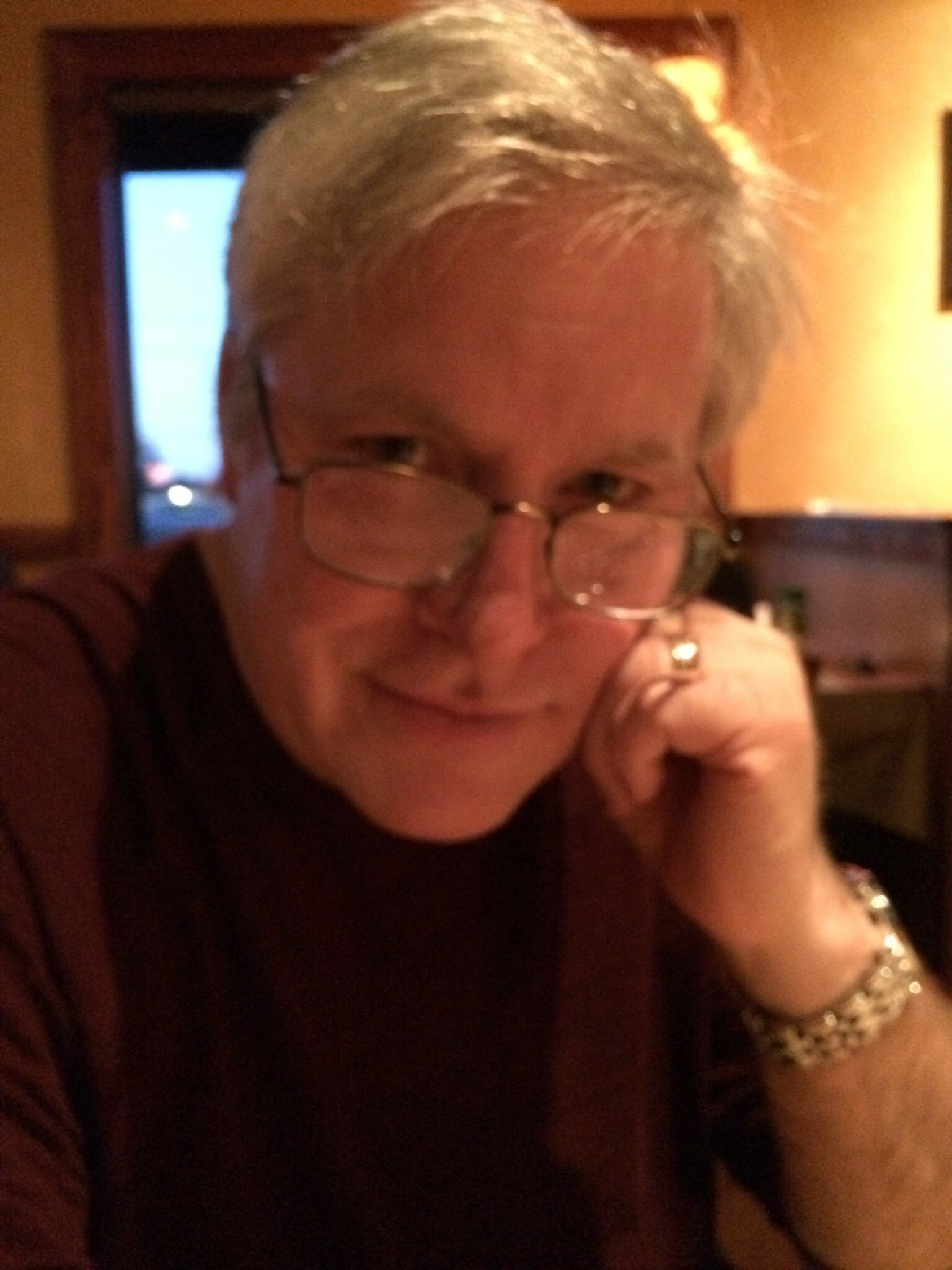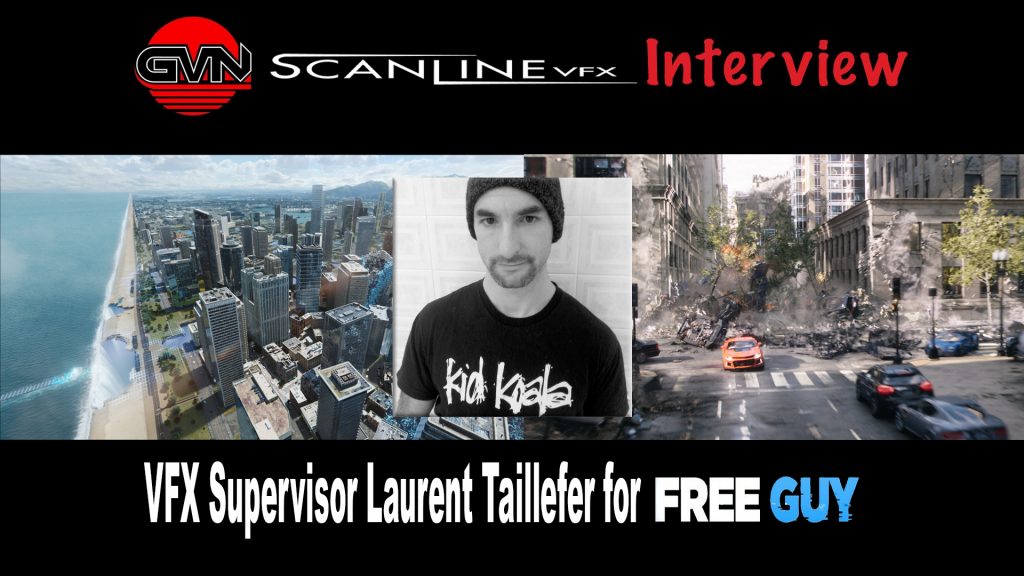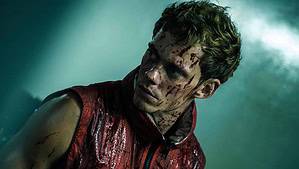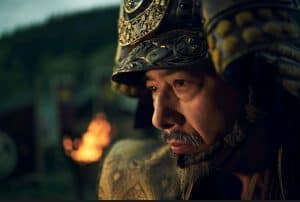When talking about Free Guy, I think the best way to start might be an excerpt from our own Dom Fisher’s Review of the film.
I hope you’re ready for all the gamer content a movie can handle in Shawn Levy’s Free Guy. This movie is the love child of GTA and The Truman Show with Fortnite as its stepdad. Facing the same type of existential crisis as the ’98 Jim Carrey film, Ryan Reynold’s Guy is also similar in personality and daily routine. He lives in a world that is seemingly real but does not actually exist. The biggest difference is, Free Guy is an outrageous and fun ride from start to finish. With explosions literally at every turn, your favorite video game streamers, some surprise cameos, and a good story, this is nothing but a good time.
So when you are making a film with video gaming elements intertwined in it, your VFX departments need to be up to the challenge. As one of the vendors responsible for that task, never let it be said that Scanline VFX wasn’t ready to produce work of the highest quality. On Free Guy, they had not one but two VFX Magicians working on their shots. VFX Supervisor Bryan Grill and Associate VFX Supervisor Laurent Taillefer helped to lead the Scanline team on the film and their results are nothing less than spectacular. As seen here.
Recently, we had the good fortune of talking to Associate VFX Supervisor Laurent Tallifer to find what went into Free Guy and how he got started.
Discovering CGI
GVN: Thanks for giving us some of your time, Laurent. As we usually do, let start with a bit of your background. When did you first taken an interest in Visual Effects work and was there a film or television show that inspired you to consider pursuing it?
LT: I got my hands on my first CGI suite around 2000, while in cinema school (3ds max, Combustion, After Effects, Elastic Reality, Realviz Matchmover…). I originally signed up with the intention of one day becoming a director, but got really caught up in the infinite possibilities of VFX. I was drawn to its combination of technical and artistic aspects – it’s the perfect mix between high-end science and unlimited creativity. As early as I can recall I’ve been curious about how VFX was made, influenced early on by movies like Tron, and then later Terminator 2 and Abyss. One thing leading to another, I taught myself to 3d and compositing, started to do FX on other student’s projects, then semi-pro shorts, and eventually started to work as a full time generalist.
Tools of the Trade
GVN: During your VFX Career, you have become proficient at a number of 3D software packages. How has this knowledge benefitted you as you have phased toward more supervisory roles?
LT: Having gone through various packages, there is a thing to be said about learning to be software agnostic. There is a fine balance between driving the artists towards what really matters in the image. The visual storytelling, and accounting for each software’s specifics. Strategic decisions about these packages can strongly impact a show’s delivery. So, having gone through that experience is instrumental.
Even as a VFX supervisor, it allows me to support the CG supe’s decisions, and help guide them when needed. Each DCCs has its pros and cons, but ultimately it’s the pairing with the artist pool that matters the most. With human resources becoming the biggest challenge these days, understanding that choosing a software will narrow the available artists to the ones that master it is key to driving a team.
Having operated these tools for years also gives me a good understanding of the processes and requirements, allowing to plan the work efficiently and target notes specifically. The downside is the temptation to be hands on. Part of being a good supervisor lies in the ability to delegate, so I always keep a close eye on my involvement – I had to learn to shift from “doing” to “teaching”
Understanding the Magic of “Houdini”
GVN: That actually makes a lot of sense. Its probably why I’ve never thought of being in a supervisory role, too much a hands-on guy. Of all the software packages that you would consider yourself proficient at, which one was the hardest to gain a mastery of, or do they all have similarities?
LT: Tough question! They all have their challenges, but for very different reasons. Background matters a lot – For example, someone coming from a procedural/nodal editing world such as Katana will grab key concepts of Houdini much easier than someone coming from a linear background, such as Maya. A lot of the difficulties lie into what I call the “pro-tips” – workarounds, hidden or counter-intuitive features, things that can only be acquired by years of experience or word-of-mouth. Some software are interfaced for easier access to a broader audience, these are usually somewhat easier to pick up – Cinema 4d, Modo, though the price to pay is more limited functionalities and scalability.
In my personal experience, Houdini has been the steepest learning curve. I was supervising a Houdini team, without any experience at the software myself, and had to backfill for our key artist leaving the production halfway. As the show needed to go on, I had to train myself to be up-and-running in an almost immediate timeframe. Setting up a studio for a Katana pipeline from scratch without having ever used the software comes in close second!
Free Guy Sequences
GVN: So let us talk Free Guy. Scanline was responsible for 404 shots across 15 sequences for the film. Going in, were there any segments that you felt might be more challenging than the others? Between Bad Ass Mansion, the Creation of Free City, The Street Squeeze, the Glitch effects and the Hitman’s Tower Transformation.
The Glitch
LT: The Street Squeeze and Server Room (glitch) sequences were definitively the big challenges of the show, as they represented a large amount of shots and the need to develop unique looks and supporting techniques. The Glitch look was worked on early on to establish what it should look like. Everyone know what a glitch is, but everyone has a different idea of what it should look like. Our aim was to deliver an effect that retained the traditional 2d feel, while taking a full 3d approach, so to maximize depth, volume and integration – After all, we are IN a video game, so seen from within, even the slightest dead pixel has a volume. We did a lot of our look development directly in Houdini, which offered enough flexibility to iterate and experiment quickly.
This slideshow requires JavaScript.
Street Squeeze
The Street squeeze sequence was also about creating a unique look. Making sure those buildings could compress in a very clean, digital way. But, at the same time, choosing to bring a real world weight and gravity to their movement. It took us a few rounds of development to find the right balance. Striving so it would feel like a clear and present threat to the actors, while still telling the story of being code-driven.
Hitman Tower
The Hitman tower was also a unique challenge – Not in its scale per se, as it really only happens in a handful of shots, but to break the mold of predictable transformation effects. Audiences have been accustomed to many mechanical transformation-based animations, so finding a visual language that was proper to Free Guy explains these shots running for several months in production.
Prep Time
GVN: The visual effects for the film looked like a large undertaking from a layman’s terms. How much preparatory time was needed, once you knew what effects that Scanline would be responsible for?
LT: A lot. As soon as we got the show award, we selected key shots (they were still in previs, as this was before the shoot even wrapped) to start to develop the look. Essentially for the glitch. This allowed us to show early tests to the director, installing a two way conversation. That way, our images are helping them imagine and orient the movie in a very collaborative way. The Street Squeeze sequence development started a bit later. Mainly because we needed a first draft of the cut to understand the city layout, architecture and styles. It’s also a sequence that went under a few editorial changes, the client experimenting with various beats and endings. We got very useful material from the Boston shoot. Building scans, textures, lighting references, which also influenced the stylization of the effect.
Car Scene
GVN: The scenes of the car careening through the city as things collapsed around it was spectacular in its execution. How much of that scene involved an actual car?
LT: Most of the shots where you see the car – at least on street level – were shot as what we call a “plate” (a fully lit usable background elements we could add effects on). As they were clear realistic references, we started by using these, tracking our cameras and CG cars to match the real one. As the layout and fx development went on, the client felt the need to take over some of the car animation – To avoid incoming dangers, for instance), so we started to swap out our CG model in some shots.
The idea was that to keep maximum flexibility, we’d build a CG version of the car that would be a 1:1 replica, with the audience not being able to tell which one is which. This allowed for us to add some damage to the car as the story progresses, and paint in reflections of the CG environment onto the windows and body. Ultimately, piece by piece, we ended replacing the car completely in most of the shots aside from a few at the head of the sequence, but to this day, no one can really tell when the switch happens! We would consistently use the real plates as reference – we also build a lighting setup tightly based on the day’s lighting situation, so the goal was to always be faithful to the actual photography.
This slideshow requires JavaScript.
Challenges
GVN: At any time during the post-production, did you run into any obstacles or scenes that were not working like you originally planned? If so, what does that require from you in your role as VFX Supervisor?
LT: Things were reasonably straight forward on this show. One of the unplanned challenges was the integration of Houdini to our production pipeline. Free Guy was part of the first wave of shows to use it, so a few unexpected issues occurred in passing data from FX into lighting. As a supervisor it became critical to support the team in scheduling for these events. Making sure we had a framework for showing work-in-progress images directly out of Houdini. While, at the same time, working out the elements into our lighting pipeline as a parallel process.
We also did a heavy usage of vRay’s post-render denoiser on this show. This is a process which allows for faster renders, but required to be setup, explained and tested. This required a bit of higher-level leadership to help with the behavioral changes and new habits. Overall, thanks to a good pre-production planning and staffing, Free Guy steered away from any major technical hurdles.
Stretching Your VFX Legs
GVN: I’ve asked this of some of your VFX cohorts, Scanline has a sterling reputation on working with pyrotechnical scenes or water and weather manipulation. Did Free Guy offer you an opportunity to stretch your effect legs and attempt something new?
LT: There’s actually very little “typical heavy fluid simulations” on Free Guy. The waterfall in the Soonami lobby, the ocean interactions around the Glitching Bridge, as well as a helicopter crash are the most worth mentioning. Which is admittedly less than our average Scanline movie. The challenges we had to overcome were really on the Houdini integration to our pipeline. Which in hindsight was plenty to keep our legs stretched!
‘Star Trek Beyond’ Memory
GVN: Thanks again for sharing with us your time and expertise. Before I let you go, I must ask about a previous project you worked on. I am a huge Star Trek fan and I noticed you worked on Star Trek Beyond in a CG Supervision role dealing with the destruction of the Enterprise and the finale sequence. Do you have any memories about that project?
LT: I do – as a fan I hope you’ll appreciate. One of our sequences took place inside the Enterprise during the swarm attack. Part of our tasks was to extend set pieces in the causeway and engine room. These were based on canon designs provided by the client. As we were iterating on them, we realized they were just not working well. Out of a leap of faith, we proposed our own in-house designs, completely reworked yet faithful to the era’s style. The client saw and loved them, allowing us to re-design key rooms of the Enterprise. Our then environment supe is also a huge fan, and I think he’s still riding that high today!
GVN: Thanks Laurent and we look forward to talking to you and to Scanline VFX in the future.

Senior Writer at GeekVibesNation – I am a 50 something child of the 70’s who admits to being a Star Trek/Star Wars/Comic Book junkie who once dove head first over a cliff (Ok, it was a small hill) to try to rescue his Fantastic Four comic from a watery grave. I am married to a lovely woman who is as crazy as I am and the proud parent of a 18 year old boy with autism. My wife and son are my real heroes.







